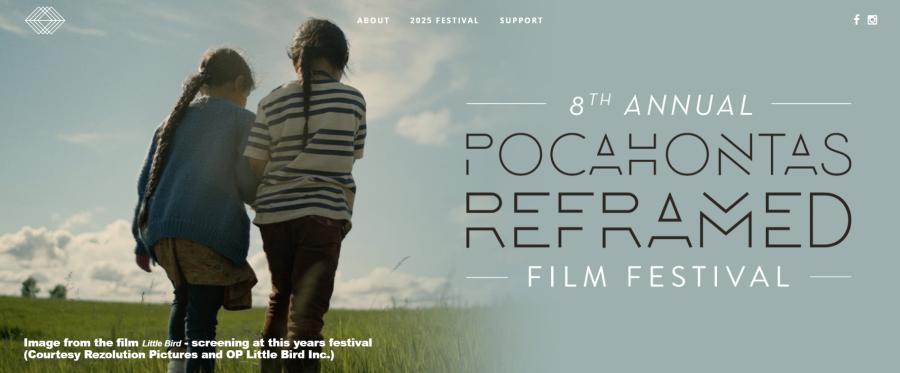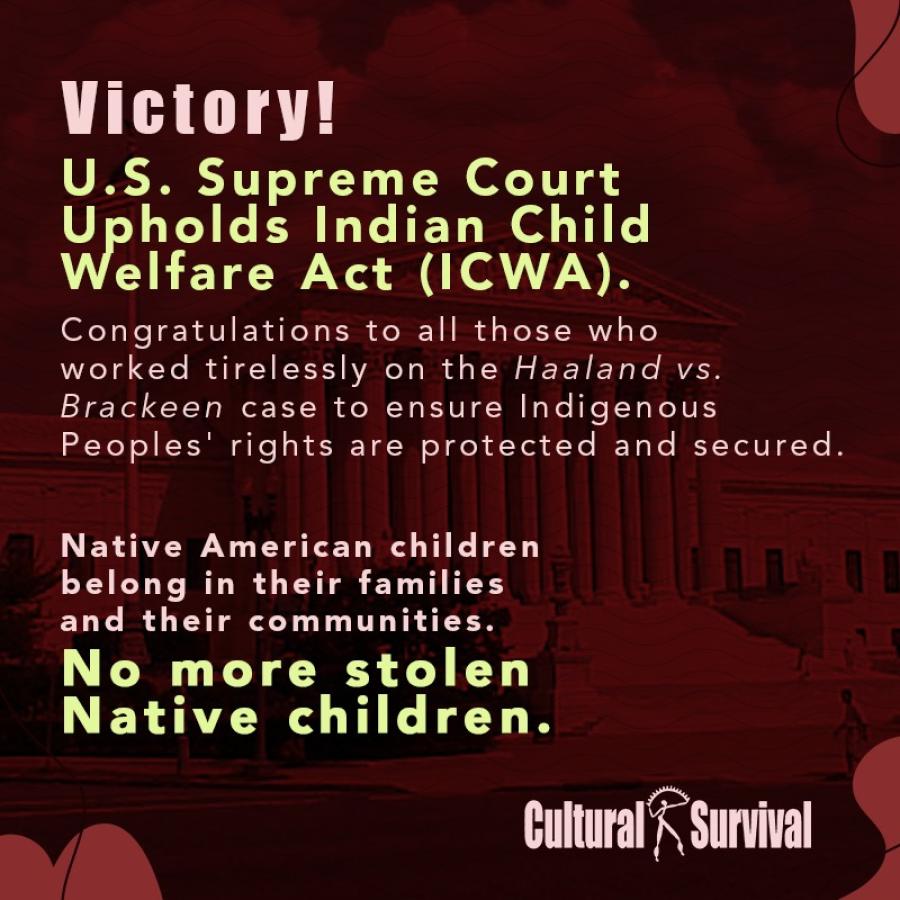
Standing in the hills overlooking the coast of England’s Plymouth Harbor, in the distance, a group of Wampanoag has gathered in a Bronze Age stone circle. It is small and humble compared to its cousin to the east, the famous Stonehenge, but it is intimate and well suited for our needs. About 10 meters in diameter, the stones stand only 3 or 4 feet in height, but unlike its famous cousin, this circle is nearly forgotten. When we arrived, we see the only visitor is a grazing cow. We can fully walk within this sacred circle; we can touch the stones. We turn to the East and begin our Song of Four Directions, making our offerings of wampum before turning and repeating to the South, West, and then the North.
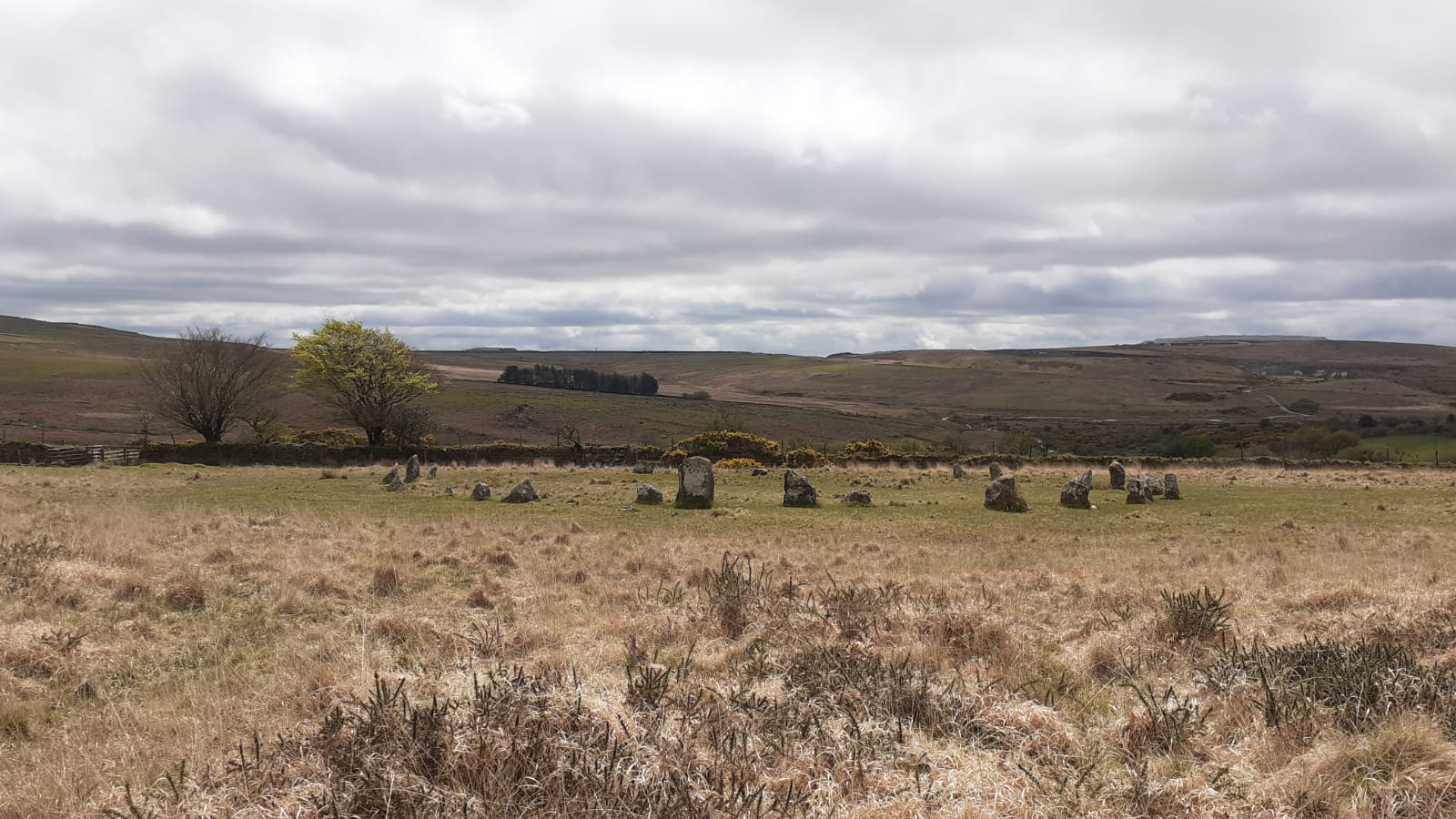
Brisworthy Stone Circle photo by Katarzyna Wosiak.
Members of the Wampanoag Nation are here to connect to the land, the land of our colonizers, to stand in the circle once held sacred before the people here were colonized, before the Roman invasion of the Celts, before Hadrian's Wall. As people connected to the Earth, this was an important step for our time in England.
In April 2023, we were brought across the ocean to perform a play, “We Are The Land," as one of the last aspects of the commemoration of the 400-year anniversary of the Mayflower voyage that brought the colonizers to our shores, to the Plymouth on the other side of the Atlantic. The play and its production are a multilayered story, much like colonization itself.
Beginning in 2017, the English theater company, Theater Royal Plymouth, began the process of consultation with Wampanoag people, seeking to tell a more truthful version of the story that we have all come to know, of Pilgrims and Indians and Thanksgiving dinner. With the best intentions and a simple lack of self-awareness, they began to write a script, a story that was to show in April 2020. And then COVID-19 hit.

Cast of "We Are the Land", Wampanoag Nation Storytellers & The People's Company. Photo by Sarah Farrow-Jones.
For the Wampanoag people, the 400th anniversary of the Mayflower, combined with the arrival of a society-changing pandemic and the added attack by the Trump administration on our sovereignty and jurisdictional authority, was deeply ironic. But the stillness of the early days of the pandemic also offered a view of other possibilities. The traffic stopped, the flights stopped, coyotes were seen roaming in the center of Boston, the world was still, and suddenly the air was clear.
The stillness and clarity allowed for reflection, and the people at Theater Royal Plymouth asked themselves an important question. “Would the play be better, if we had the Wampanoags write it themselves?” A question, I have no doubt, that everyone involved is happy they asked. However, I am also certain that for all parties the decision to take on this difficult process must have been questioned.
For the staff at Theater Royal Plymouth, this was a real learning experience. We had to have a number of hard and frank discussions about what it takes to make this work a reality, about the difference between a community project, where actors volunteer for the chance to be on stage, versus the industry standard of expecting free labor from Indigenous communities. There is a need to look at how this fits a historical pattern of extraction and relies on an imbalance of power. But when all sides are truly committed, a mistake is simply an opportunity to learn.
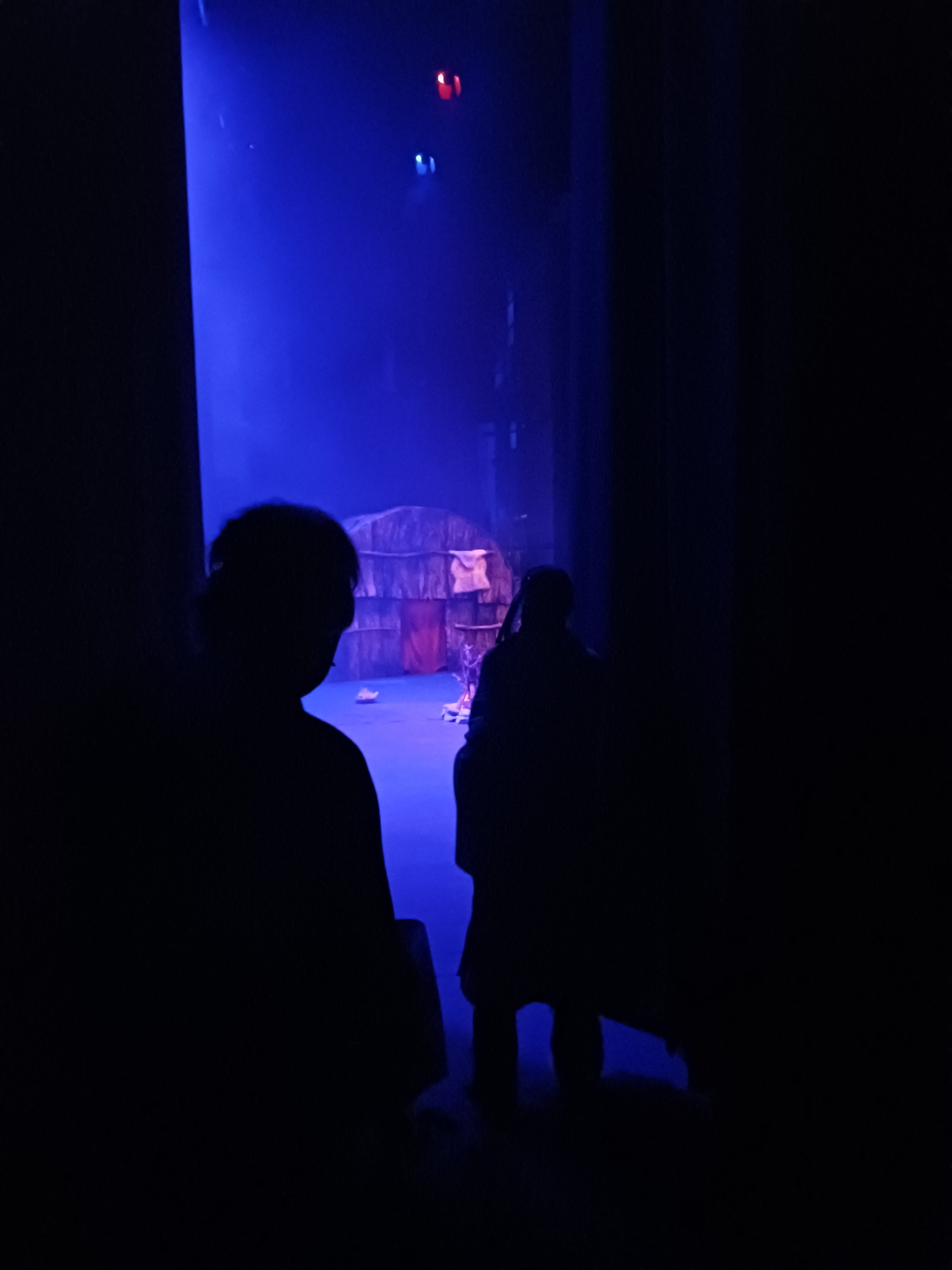
Shot from the wings, the last rehearsal of the first act. Photo by Hartman Deetz.
Executive Director Mandy Precious said so eloquently in her speech at the cast party that wrapped up the event that she “had learned, through many missteps, so much in having to give up space, relinquish power, and recognize undue privileges.” The head of production, Hugh Borthwick, said “It is amazing what can be accomplished when we stop worrying about who gets the credit for it and just get it done.” It has been an emotionally challenging process for all of us, but I truly commend the folks at Theater Royal Plymouth for sticking it out and showing the humility to commit to the hard work.
With the exception of three out of the 16 members of the cast and crew, the Wampanoag people involved were largely amateurs with little to no stage or theater experience. Many of us did not understand the sheer amount of work we had committed to. Siobhan Brown (Mashpee Wampanoag) took on the role of stage director for the play as a professional theater worker with experience in acting and directing. Together with Siobhan, we made it a priority to approach the project in a decolonized way, as equals, all having important things to contribute. Even among ourselves, decolonizing is an ongoing process.
As for my part, I was able to help our group pull together the thousand and one ideas into a single cohesive storyline. We drew from the historians in the group to provide some of their favorite nuanced moments of everyday people, we looked to the cast members to help fill the void left out of the record with their own humanity, and we looked to elders to draw from their own life experience and memory.
The truth is, we could never tell our whole story in an hour and fifteen minutes on stage, so our week of events sought to show a spectrum of who we are as a Peoples. We had presentations about the ongoing impacts of colonization, the work of Native Land Conservancy, a showing of the film “Mashpee Nine,” and a discussion about police brutality and racial oppression, as well as performances of our traditional Wampanoag Nation Singers and Dancers and an evening of contemporary music organized by Asa Peters (Mashpee Wampanoag).
In the end, we were able to put 400 years and more of our story on stage in 4 acts. Starting in the myth of our memory, the age of giants and prophecy, we skipped over the Mayflower arrival and moved into the after effects, the forced conversion, religious persecution, the seeds of discontent that brought about our war with the colonists, the racialized oppression that took root after we took on the Christian faith, the hypocrisy of a new nation founded on liberty freedom and justice for all….but not for “the merciless Indian savage” to the neo-colonialism of redlining and gentrification that continue to force us out of our homelands to this very day. We laid the history of our experience out on the stage and then gave the cast, as real living examples, the opportunity to speak of testaments to our hope and survival. These statements helped to pull us up from the depths, to show in the end we are more than the victims of the trauma we have endured, and that in spite of it all, we are vibrant, thriving people, real as the Earth itself.
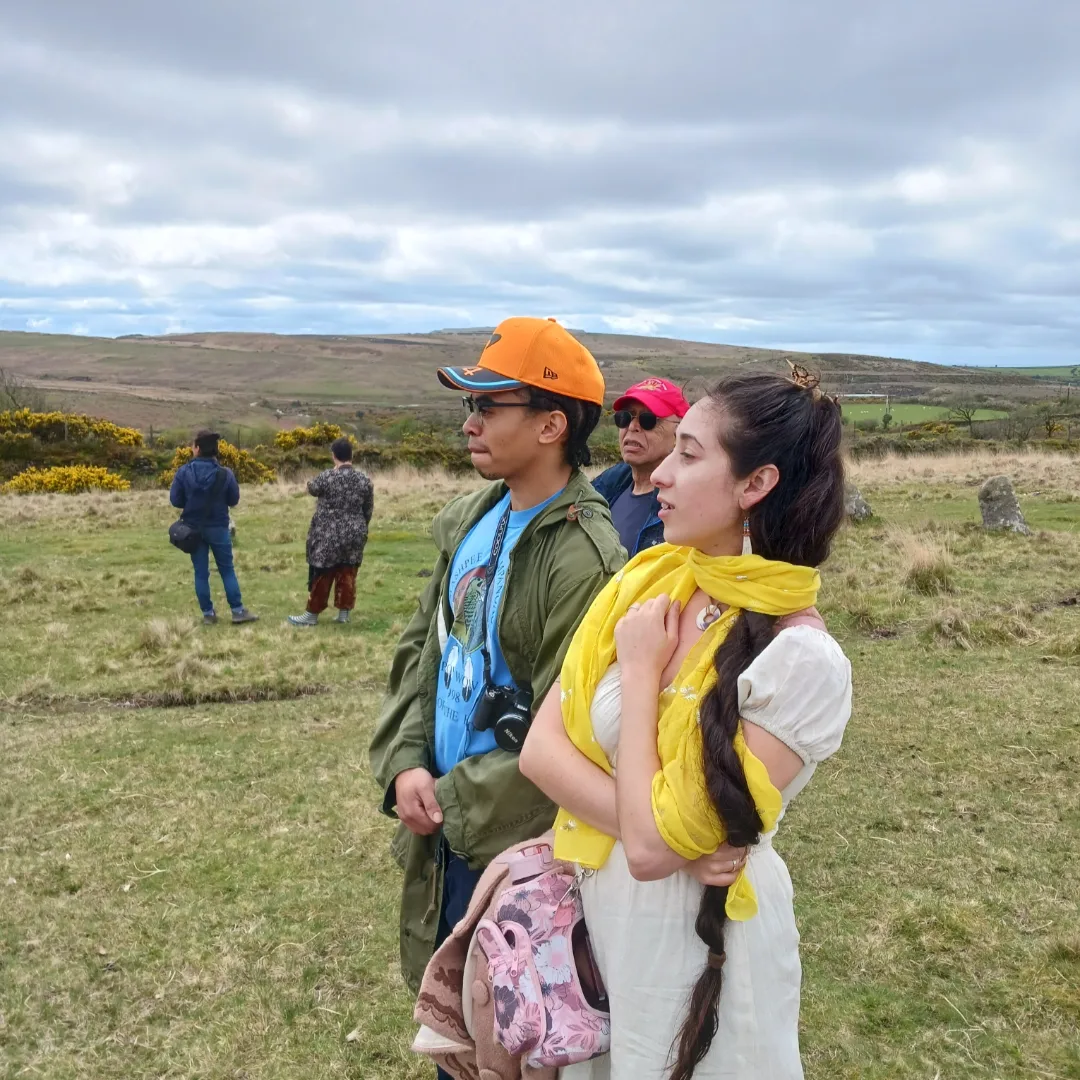
Back to front: Jim Peters, Asa Peters, and Jasmin Rochelle Goodspeed at Brisworthy Stone Circle. Photo by Hartman Deetz.
Art is powerful because it allows us to imagine the world as we want it to be. The power of creation is sacred as we see it, it is how we serve our highest purpose, to have meaning to connect to our humanity and our spirit. To create beauty is to emulate the creator in our actions and our essence. More than essays facts and statistics, the conveying of our emotional reality to other human beings, to find space for empathy and connection, is how we overcome the dehumanizing powers of divide and conquer; that which divides us from our fellow human family, as well as the animals and plants and the whole system of life that we share this world with.
Even here in England, the seat of one of the most expansive colonial powers the world has ever known, where goods and treasures were looted and pillaged from around the world, we were welcomed with a common thread of humanity. We were gifted Scottish tartans and even eagle feathers. The Lord Mayor Sue Dann greeted us with real tears on her cheeks, and gave a good speech in the lobby, saying we must learn from the past, but truly it is about what we do from here.
Colonization has impacted us all. The process has dehumanized both the colonized and the colonizer, and to regain our humanity we must come together to heal and repair the damage. When the offer was given to go out to a small stone circle on a quiet hillside above the outskirts of town, we jumped at the chance. I said to Sarah, our host, that the Druids were like England’s Indians; after all, everyone is indigenous to somewhere. As Wampanoags, we have been in our homeland as long as the English have been in England. Looking in the center of one of these stone circles, we saw fresh cut flowers had been placed as an offering.
--Hartman Deetz (Mashpee Wampanoag) has been active in environmental and cultural stewardship for over 20 years. He is a traditional artist as well as a singer and dancer, having shown his art in galleries and performed for audiences from coast to coast across the U.S. He is currently a 2023-2024 Cultural Survival Writer in Residence.
Top photo: Members of the Wampanoag Nation are greeted by Plymouth's Lord Mayor Sue Dann at the Mayflower Steps where the ship departed in 1620. Photo by Steven Hendricks.

